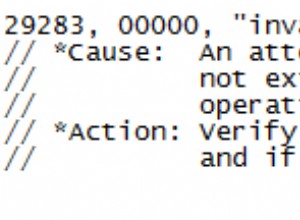Để làm cho ví dụ của bạn hoạt động, bạn có thể thử cách này.
define('DB_CONN','mysql:dbname=;host=');
define('DB_USER', '');
define('DB_PASS', '');
interface iMySQL
{
public
function query( $string );
public
function select();
public
function selectAll();
public
function insert();
public
function update();
public
function delete();
public
function load();
}
class DataBase
{
/**
* @var object PDO
*/
private static $instance = null;
/**
* Cria uma instância do PDO representando a conexão ao banco de dados e torna a instância disponível como "singleton"
*
* @param string $dsn O DSN completo, ex.: mysql:host=localhost;dbname=testdb
* @param string $username O nome de usuário para a string DSN. Esse parâmetro é opcional para alguns drivers do PDO.
* @param string $password A senha para a string DSN. Esse parâmetro é opcional para alguns drivers do PDO.
* @param array $driver_options Um array key => value de opções de conexão específicas do driver
*
*/
private function __construct() {
}
public static function getInstance()
{
if ( self::$instance === null )
{
self::$instance = new PDO(DB_CONN, DB_USER, DB_PASS);
}
return self::$instance;
}
}
class Model
{
protected $TABLE_NAME;
protected $TABLE_PREFIX;
protected $clausula;
private $storage;
/**
* Recupera um registro utilizando sua chave
*
* @param string $key
*
* @return mixed O valor armazenado
* @throws RuntimeException Se não houver um registro para a chave especificada
*/
public
function __get( $key )
{
}
/**
* Registra um valor à uma chave
*
* @param string $key A chave que será utilizada no registro
* @param mixed $value O valor que será registrado
*
* @throws LogicException Se a chave já estiver registrada
*/
public
function __set( $key , $value )
{
//echo $key;
}
public static
function __callStatic( $method , $args )
{
$database = DataBase::getInstance();
$callback = array( $database , $method );
return call_user_func_array( $callback , $args );
}
public
function __call( $method , $args )
{
$database = DataBase::getInstance();
$callback = array( $database , $method );
return call_user_func_array( $callback , $args );
}
public function __construct( $table_name = null , $id = null )
{
$this->TABLE_PREFIX = $this->config['database']['table_prefix'];
$this->TABLE_NAME = $this->TABLE_PREFIX . $table_name;
$this->storage = new ArrayObject();
if ( !is_null( $table_name ) )
{
$array = $this->query( "SHOW COLUMNS FROM `$this->TABLE_NAME`" )->fetchAll();
$colunas = array();
$obrigatorias = array();
foreach ( $array as $value )
{
$colunas[] = $value[0];
if ( $value['Null'] === 'NO' )
{
$obrigatorias[] = $value['Field'];
}
}
$this->colunas = $colunas;
$this->obrigatorias = $obrigatorias;
$this->total_colunas = count( $this->colunas );
// Se passou um id por parâmetro, salva nas propriedades do objeto
if ( !is_null( $id ) AND is_numeric( $id ) )
{
$this->id = $id;
// E já carrega o objeto
$select = $this->query( 'SELECT * FROM {tabela_nome} WHERE `id` = ' . $id )->fetchObject();
$this->load( $select );
}
}
}
public
function insert()
{
}
public
function update()
{
}
public
function delete()
{
}
public
function select( $clausula = NULL , $is_array = FALSE )
{
// Caso seja passado uma cláusula diretamente para a função, executa ela
if ( !is_null( $clausula ) )
{
$this->clausula = $clausula;
}
// Troca uma possível variável pelo nome da tabela do Model
$this->clausula = ( str_replace( '{TABLE_NAME}' , $this->TABLE_NAME , $this->clausula ) );
$this->clausula = ( str_replace( '{TABLE_PREFIX}' , $this->TABLE_PREFIX , $this->clausula ) );
// Executa o SELECT no banco de dados
$query = $this->query( $this->clausula );
if ( $query AND $query->rowCount() > 0 )
{
if ( $query->rowCount() == 1 AND !$is_array )
{
return $query->fetchObject( get_class( $this ) );
}
else
{
$objetos = array();
while ( $linha = $query->fetchObject( get_class( $this ) ) )
{
$objetos[] = $linha;
}
return ( count( $objetos ) > 0 ) ? $objetos : FALSE;
}
}
else
{
return FALSE;
}
}
public
function selectAll()
{
}
public
function load()
{
}
}
$model = new Model();
$stmt = $model->query();
$fetch = $stmt->fetchAll();
var_dump($fetch);
Điều này không được thử nghiệm. Nhưng nó sẽ cung cấp cho bạn ý tưởng về cách giải quyết vấn đề. Hãy thử cách tiếp cận này.
define('DB_TYPE', 'DB_Class_One');
class DB_Class_One extends PDO {
public function getData() {
print 'Class One';
}
}
class DB_Class_Two extends PDO {
public function getData() {
print 'Class Two';
}
}
class DB_Class_Three extends PDO {
public function getData() {
print 'Class Three';
}
}
class DataBase {
private static $instance = null;
private function __construct() {
}
private function __clone() {
}
public static function getInstance() {
$class = DB_TYPE;
if (self::$instance === null) {
self::$instance = new $class("mysql:host=;dbname=", '', '');
}
return self::$instance;
}
}
$db = DataBase::getInstance();
$stmt = $db->query();
$result = $stmt->fetch();
$db->getData();




